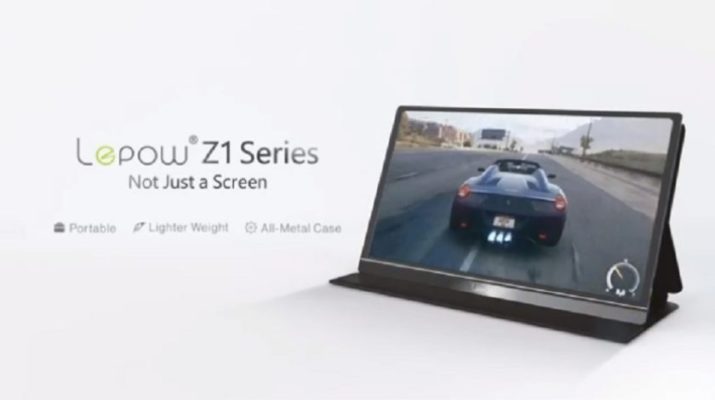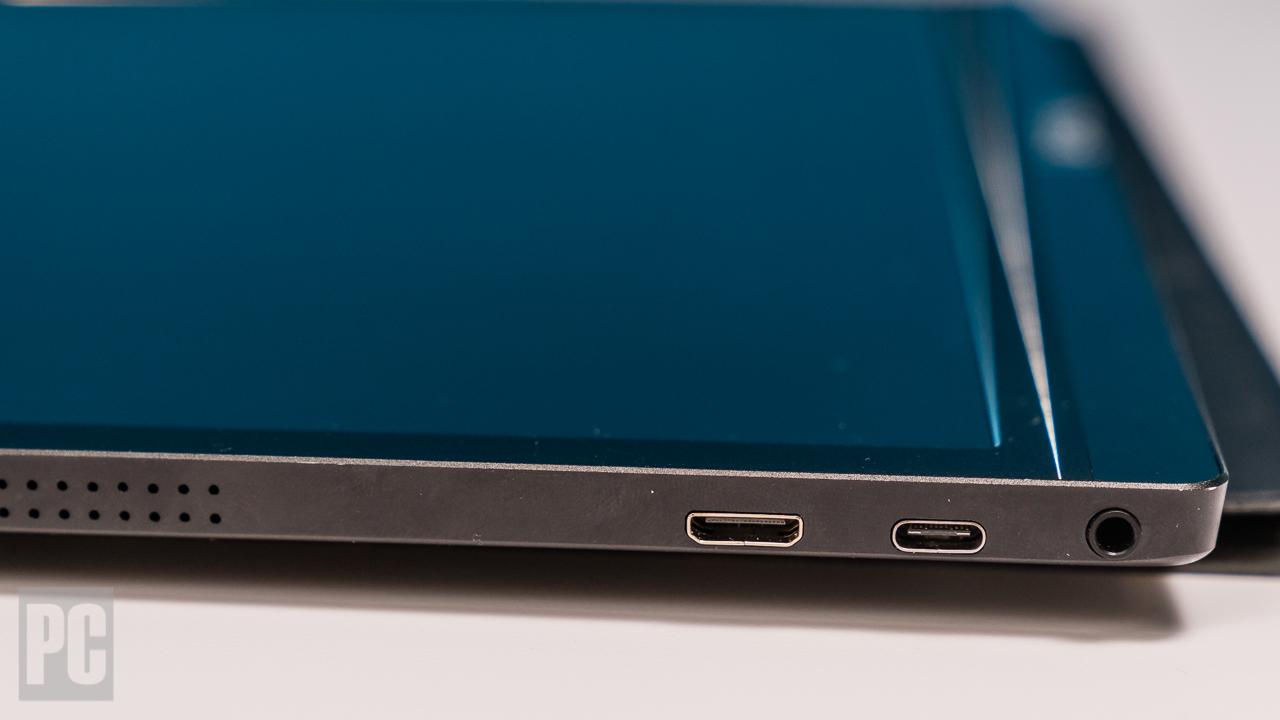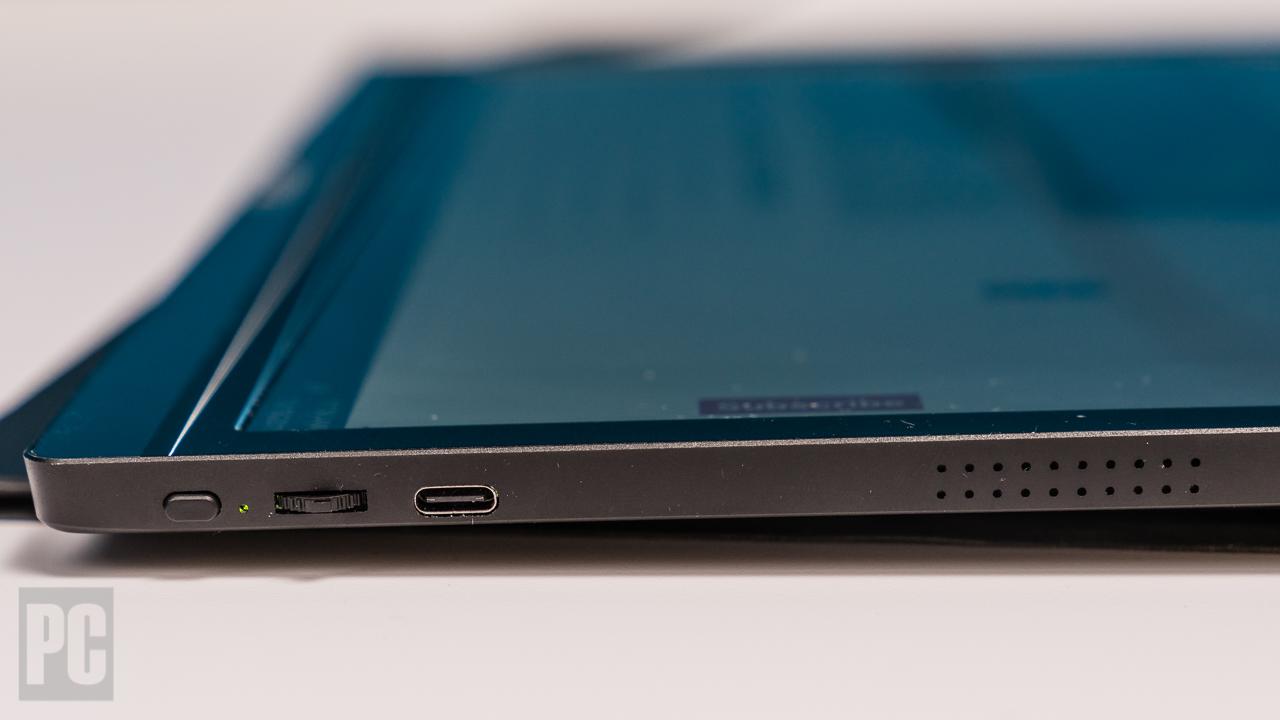Lepow monitor is compatible for laptops, PCs, Phones, PS3/4, XBOX ONE, Wii or Nintendo Switch etc. The smart cover is made with a durable PU leather exterior, a soft lining to keep your monitor safe. It can fold into different positions to create a stand of reading, typing or watching. And the screen protector makes it fully protective from the scratches. You can connect your devices to this portable monitor easily via Type-c or Mini HDMI port to play business presentations, games, videos, TV series, photos etc. Reveal more features in Lepow portable monitor review.
In the box
Before we go any further, let’s take a look at what comes in the box. Of course, you get the Lepow Portable Monitor. But there are a few extras that add even more value. Here’s what you get:
- Foldable magnetic cover
- Transparent screen protector
- USB Type-C to Type-C cable
- USB Type-A to Type-C cable
- HDMI to Mini HDMI cable
- Owner’s manual
Specifications – Lepow portable monitor
- Screen size: 15.6 inch
- Visual area: 344.16 x 194.59mm
- Panel type: IPS
- Dimensions: 368 x 225 x 8.8 mm
- Aspect ratio: 16:9
- Resolution: 1920×1080
- Display color: 16.7M
- Color temperature: 6800K
- Visual angle: H: 85/85Min V:85/85Min
- Contrast ratio: 1000:1
- Brightness: 300cd/m2
- Output interface: 3.5mm headphone jack
- Speaker: 1Wx2
Pros & Cons – Lepow portable monitor
Pros
1. Lightweight
2. Satisfying picture quality
3. In-the-box accessories included, along with slim cover.
4. The price is unbeatable.
5. Works with all of my devices (Xbox One, Xbox 360, Tab S4, Mate 10, Note 9, Dell XPS 15).
Cons
1. Speakers could be louder.
2. Not true HDR; Settings for HDR are washed out, not sure what the setting “auto” does in HDR mode.
3. Not sure why sometimes the menu settings are greyed out and therefore not selectable. Sometimes it works, sometimes it doesn’t. (This may be an oversight on my part but If I want to raise the backlight setting, why am I not able to select it at times?)
Price & availability
I’m glad that I acquired the 15.6-Inch Lepow Portable Monitor while it was on sale. It lets me bring a second screen larger than my laptop’s on the road with me, and it provides both USB-C and HDMI connectivity. I can power it either from an AC adapter or from my laptop. Its only significant downsides are its limited gamut and dull colors, which make it a less-than-ideal choice for watching movies or working with photos.
Although I can no longer find it for $109, even at its list price of $169.99 the Lepow is not a bad deal. This is less than you’d pay for the similarly equipped AOC I1601FWUX, which has the same screen size and resolution and similar color issues but just a single USB port. Should you want a really good mobile monitor for both personal and business use, however, I suggest you spring for our current Editors’ Choice Lenovo ThinkVision M14. Not only does it have the widest color gamut of all the portable monitors we’ve tested recently, but it’s also much brighter. And instead of a relatively flimsy foldable stand and protective cover, it uses a hinged panel that attaches to a small base that houses its ports, giving it a wide range of tilt angles.
Is any good in Lepow portable monitor?
Lepow USB C Monitor delivers stunning 1080P resolution visuals with awesome color reproduction. The IPS screen shows you a vivid image and an awesome viewing experience when extending your screen or playing games.
Lepow monitor comes with a USB C and Mini HDMI port that is compatible for your laptops, PCs, Phones, PS3/4, XBOX ONE, Wii or Nintendo Switch etc.
The smart cover is made with a durable PU leather exterior, a soft lining to keep your monitor safe. It can fold into different positions to create a stand of reading, typing or watching. The screen protector makes it fully protective from the scratches.
With a slim 0.3-inch profile and just 1.76 pounds, Lepow 15.6 inch monitor is ideal for your life and work. Lepow offers you the best service and 3-Year warranty.
Compare Lepow portable monitor (review)
| Lepow Z1-Silver | Lepow Z1 Gamut-Grey | Lepow Z1 Pro-Night Blue | |
|---|---|---|---|
| Model | Z1 | Z1 Gamut (2020) | Z1 Pro |
| Color gamut | 72% NTSC | NTSC=85%, SRGB=100%, AdobeRGB=90% | 72% NTSC |
| Brightness | 300cd/m² | 320cd/m² | 300cd/m² |
| System | LSO 3.0.0 | LSO 3.0.2 | LSO 3.0.1 |
| Color | Silver | Grey | Night Blue |
| Resolution | FHD 1080P | FHD 1080P | FHD 1080P |
| Net Weight | 1.7 lbs | 1.7 lbs | 1.7 lbs |
| Size | 15.6 inch | 15.6 inch | 15.6 inch |
Lepow portable monitor review
Protective case
The Lepow comes with a protective cover, matte black on one side and gray on the other, that doubles as a foldable stand. Unlike the HP EliteDisplay S14 and the AOC I1601FWUX, whose covers protect only the display panel, the Lepow cover’s folds around the display to shield both front and back.
Size & build
A matte-black slab with rounded corners, the Lepow monitor measures 0.3 by 14.4 by 8.7 inches and weighs just 1.7 pounds. The bezels are relatively thin for a mobile monitor: 0.25 inch at the top, 0.4 inch on each side, and 0.8 inch below. On the unit’s left edge are a mini-HDMI port, a USB-C port, and a 3.5mm audio-out jack…
On the right edge are the power button, a wheel for navigating the onscreen display (OSD), and another USB-C port, this one for powering the display. There’s also a speaker grille on each side.
Ports & Connectivity
While the AOC I1601FWUX and the HP EliteDisplay S14 each comes with a single USB Type-C port, and the Lenovo ThinkVision M14 has a pair of them, the 15.6-inch Lepow includes two USB-C ports and one mini-HDMI port. While one of the former supports video input (using DisplayPort over USB, which allows data, video, and power transfer), the other is strictly for powering the monitor in situations where the host device can’t handle the power load. Lepow bundles a USB-Type-C-to-A cord and an AC adapter for this purpose. The Lepow can also be powered from a laptop. I mostly ran it connected via USB Type-C cable to my Dell XPS 13 ultraportable, with the Lepow panel drawing its power from that notebook.
The selection of ports lets you connect the display to a gaming console such as a Sony PlayStation 3, a PS4, an Xbox One, or a Nintendo Switch, and even to some smartphones, in addition to a laptop or desktop.
Stand
As with similar stands we’ve encountered, one edge contains a magnetized strip that adheres to and props up the top rear of the monitor, while the display’s bottom edge fits into one of two grooves to give you a little control over its tilt angle. There is no height adjustment.
The stand supports only landscape mode, unlike that of the AOC I1601FWUX, which can also hold the panel in portrait mode once you pivot it by hand. You can prop up the screen, however, against a surface in a vertical orientation or lay it flat in front of you. The included user guide shows you how to rotate the onscreen image to portrait mode in Windows to match the monitor’s physical rotation.
How good is On-Screen-Display?
You can access the device’s onscreen display (OSD) using the aforementioned wheel (a.k.a. roll key), which is in effect a small button on a tiny geared wheel. You can either push the button in (to open the OSD or select a menu choice) or rotate the wheel up or down (to navigate between menu items or adjust values such as brightness or contrast). While not as easy as the mini-joystick controls of many desktop monitors, the wheel proved a cinch to use with a little practice. I preferred it to the multi-button control systems still found on many mobile and desktop displays alike.
Color
The first menu choice, labeled Brightness, lets you control brightness, contrast, black level, and sharpness over a range of 0 to 100. (Note that when you turn on the Lepow, its brightness defaults to 30 percent, so unless you plan to be away from a power source other than your laptop for a long time, you may want to turn it up.) Next is the Image menu. The first item, called Eco, lets you choose among six picture modes: Standard, Game, Movie, Text, RTS, and FPS. The second, DCR, lets you enable or disable dynamic contrast ratio. The third, Aspect, lets you choose between a 16:9 widescreen aspect ratio or the classic 4:3 ratio.
From the Color Temperature menu, you can choose among Cool, Warm, and a user mode that lets you set red, green, and blue values individually. Then there are three OSD Setting menus, which let you perform tasks such as choosing a language, muting or adjusting the speaker volume, selecting a port (USB-C or HDMI) for the signal source, enabling a low-blue-light mode, performing a factory reset, and enabling or disabling the high dynamic range (HDR) mode, which I’ll discuss below.
Temperature
Surface temperatures are warmest near the bottom left corner and coolest near the opposite corner with a difference of almost 12 degrees C. The hot spot is close to the USB Type-C port where the monitor receives its power.
Power Consumption
The monitor consumes on average 2.9 W and 7 W when on the minimum and maximum brightness settings, respectively. A generic USB Type-C charger can power the display so long as it outputs at least 5V/2A.
Lepow portable monitor performance review
The Lepow is the first mobile monitor I’ve reviewed that has an HDR mode. Labeled 2,084, the setting is essentially the HDR10 standard used in nearly all HDR monitors. I went into the Windows 10 display menu and checked the Windows HD Color settings, but they showed no indication that the Lepow could support HD video or gaming, which is unusual because almost every HDR-enabled monitor that we’ve tested over an HDMI connection can. This led me to suspect an HDR emulation—that is, various tweaks to color, contrast, and brightness designed to simulate true HDR. Nonetheless, I ran the monitor through our tests again with the HDR setting enabled, and it showed a boost in brightness to 196 nits. I measured its contrast ratio at 1,146:1, a bit greater than its 1,000:1 rating.
As usual, I did our luminance and color testing in standard mode using a Klein K10-A colorimeter, a Murideo Six-G signal generator, an X-Rite i1Basic Pro 2 color profiler, and Portrait Displays’ CalMAN 5 software. Lepow rates the 15.6-inch Portable Monitor’s luminance at 300 nits (candelas per meter squared), a very bright rating for a mobile display, but I measured only 169 nits. This is within the narrow brightness range in which most mobile monitors fall; a notable exception is the Editors’ Choice Lenovo ThinkVision M14, which produced a sunny 280 nits in our testing.
A Pinched Color Gamut
In our color testing, the Lepow covered just 65.4 percent of the sRGB color space (see the chromaticity chart below). The triangle represents the colors that comprise sRGB—essentially, all the colors that can be made by mixing different percentages of red, green, and blue. The white boxes show where the data points would be for a monitor that covers the full sRGB space. Things were no better when I ran the test a second time, but in HDR mode.
Most desktop monitors exceed 90 percent in their sRGB coverage, as do a few mobile monitors—the Lenovo ThinkVision M14 wowed us with 97 percent. Most recent portable monitors have tested closer to the Lepow; the AOC covered a mere 61.4 percent of sRGB. The HP EliteDisplay S14 and the Hori Portable Gaming Monitor Pro, though we did not measure their color gamuts by percentage, showed the same pattern, with the crimped color space on the red/purple side of the spectrum and the blue point out of the triangle and toward the green, leading me to suspect that all these panels except the Lenovo’s came from the same source.
Several of our test points—the black circles—are well within the triangle, indicating that this panel can display about two-thirds of the sRGB colors, especially toward the red/purple/blue part of the spectrum. The blue circle is slightly outside of the triangle, meaning the Lepow covers a tiny range of blues and greens beyond the sRGB spectrum.
Subjectively, I tested the Lepow at home, in coffee shops, and in the office by viewing our usual selection of photos, video clips, and websites, as well as working with office documents. The results were similar over both USB-C and HDMI connections. As expected based on our color testing, reds and purples frequently looked muted (see the photo below).
This renders the monitor fine for business or casual use, but a poor choice for videophiles or photo editors.
HDR: Seeing Red
As mentioned, the Lepow is one of the few mobile monitors with built-in speakers. Sound from the two 1-watt speakers was clear but feeble, so I switched the audio output back to my laptop with its louder speakers. The Lepow’s own would be of most use to people connecting from a video source without speakers, such as a game console. There is a 3.5mm audio-out jack to connect to headphones or a set of powered speakers. Either would be a better bet.
I also tried the HDR feature with both photos and videos over both USB-C and HDMI connections. It definitely had an effect, increasing contrast and punching up the color, but to a point that sometimes bordered on the garish. This may provide one advantage in gaming—it’s harder for an enemy to hide from you. Reds were significantly oversaturated, to the point that, on looking at a photo of myself sitting in a faux Game of Thrones Iron Throne at an event I’d attended, I found myself wondering when Westeros had acquired a red king.
Lepow provides a three-year warranty for the display, which is typical of monitor warranties.
Editor’s recommendations
- Cocopar 17.3 portable monitor review – is it USB Type C compatible?
- Artisul D16 Pro 15.6 inch pen display review
- UPERFECT 4K computer monitor 15.6 gaming display portable review
- Microsoft Surface Book 3 vs Dell XPS 15 – are they good for gaming?
- 2020 XIDU PhilBook Max review – is it worth buying?
- What is good in XIDU PhilBook Pro Touchscreen laptop?






